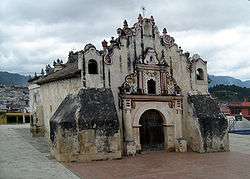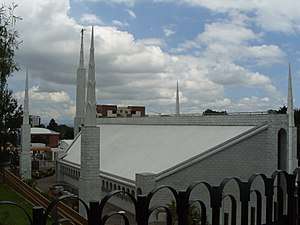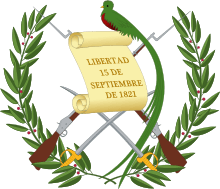Religion in Guatemala
Christianity remains strong and vital for the life of Guatemalan society, but its composition has changed considerably in recent decades.
Religion in Guatemala (Pew Research Center 2014)[2]

Roman Catholicism was the official religion in Guatemala during the colonial era and currently has a special status under the constitution.[1] Pentecostal (Pentecostals are called Evangélicos in Latin America) and later Eastern Orthodoxy and Oriental Orthodoxy have increased in recent decades. About 42% of Guatemalans are Protestant, chiefly independent Evangelicals or Pentecostals. The Eastern Orthodox Church and Oriental Orthodoxy claim rapid growth, especially among the indigenous Maya peoples.
Statistics
| Group | % 2000 | % 2010 | Pop. 2000 | Pop. 2010 |
|---|---|---|---|---|
| Roman Catholicism | 52.9% | 47.1% | 6.138.256 | 6.930.718 |
| Pentecostalism | 17.7% | 22.7% | 2.053.821 | 3.340.282 |
| Non-Religious | 15.9% | 12.3% | 1.844.958 | 1.809.932 |
| Independent evangelical | 3.3% | 8.9% | 382.915 | 1.309.626 |
| Eastern Orthodoxy | 3.1% | 3.1% | 359.708 | 456.161 |
| Historical Evangelical Denominations | 2.1% | 2.7% | 243.673 | 397.302 |
| Seventh-day Adventist | 1.5% | 1.1% | 174.052 | 161.863 |
| Other Religions | 1.0% | 0.8% | 116.035 | 117.719 |
| Mormon | 1.1% | 0.7% | 127.638 | 103.004 |
| Jehovah's Witness | 0.6% | 0.4% | 69.621 | 66.217 |
| Maya religion | 0.8% | 0.4% | 92.828 | 60.859 |
| Total | 100.0% | 100.0% | 11.603.510 | 14.714.901 |
Religious freedom
The constitution of Guatemala establishes the freedom of religion. While it is not a state religion, the Catholic Church is recognized as "a distinct legal personality" that receives certain privileges.[4]
According to the constitution, no member of the clergy of any religion may serve as president, vice president, government minister, or as a judge.[4]
Registration for religious groups is not required, but provides access to property purchase and tax exemptions.[4]
The constitution includes a commitment to protect the rights of indigenous Maya groups to practice their religion. Mayan religious groups are allowed to use historical sites on government-owned property for ceremonies. However, representatives of Mayan groups have complained that their access is limited and subject to other obstacles, such as being required to pay fees.[4]
Public schools may choose to offer religious instruction, but there is no national framework for such classes. Private religious schools are allowed to operate as well.[4]
Roman Catholic

Catholicism was the established religion during the colonial era (1519–1821) and reestablished under the Concordat of 1854 until the fall of Vicente Cerna y Cerna in 1871. It is common for relevant Mayan practices to be incorporated into Catholic ceremonies and worship when they are sympathetic to the meaning of Catholic belief a phenomenon known as inculturation.[5][6] The Catholic Church remains the largest denomination or church in the country. Within this Catholic Church, there are also a large number of Charismatic Catholics, part of the global Catholic Charismatic Renewal.[7]
Protestantism
Current estimates of the primarily Evangelical Protestant population of Guatemala are around 40 percent, making it the most Protestant country in Latin America.[8][9] Most of these Protestants are Pentecostals.[10] The first Protestant missionary, Frederick Crowe, arrived in Guatemala in 1843, but Conservative President Rafael Carrera expelled him in 1845.[11] Protestant missionaries re-entered the country in 1882 under the patronage of Liberal President Justo Rufino Barrios. These Northern Presbyterian missionaries opened the first permanent Protestant church in the country in Guatemala City, which still exists one block behind the presidential palace in zone 1 of Guatemala City.[12]
Protestants remained a small portion of the population until the late-twentieth century, when various Protestant groups experienced a demographic boom that coincided with the increasing violence of the Guatemalan Civil War. Two Guatemalan heads of state, General Efraín Ríos Montt, who in 2013 was found guilty of genocide and crimes against humanity, and Jorge Serrano Elías, have been practicing Protestants. They are the only two Protestant heads of state in the history of Latin America.[13][14] Large portions of the nations Mayan population are Protestants, especially in the northern highlands.
Eastern Orthodox and Oriental Orthodox Christianity
According to a Guatemalan Orthodox monastery, Orthodox Christianity arrived in Guatemala at the end of the 19th century and beginning of the 20th century with immigrants from Lebanon, Russia, and Greece.[15] In the 1980s two Catholic women, Mother Ines and Mother Maria, converted to Orthodox Christianity and established a monastery. In 1992 they were received into the Antiochian Patriarchate and in 1995 the Catholic Apostolic Orthodox Antiochian Church in Guatemala was formally established. The state orphanage of Hogar Rafael Ayau, established in 1857, was privatized and transferred to their care in 1996.[15]
In 2010 a religious group which had begun as a Catholic movement under a priest, Andrés de Jesús Girón (died 2014, also known as Andrew Giron), was received into the Eastern Orthodox Church by the Ecumenical Patriarchate of Constantinople and placed under the Greek Orthodox Metropolis of Mexico.[16][17][18]
The Non-Chalcedonian Syriac Orthodox Church of Antioch, which is part of the Oriental Orthodox communion, received as many as 500,000 converts from a schismatic Catholic denomination in 2013. The Syriac Orthodox Patriarchal Vicariate of Guatemala is led by Archbishop Mor Yacoub Edward.[19]
Both Eastern and Oriental Orthodox converts are almost largely made up of indigenous Mayans, a historically persecuted ethnic minority in Guatemala.
The Church of Jesus Christ of Latter-day Saints

The Church of Jesus Christ of Latter-day Saints in Guatemala claims over 255,000 members in 421 congregations in Guatemala which, if accurate, accounts for approximately 1.6% of Guatemala's estimated population in 2015.[20] The first member of the LDS Church in Guatemala was baptized in 1948. Membership grew to a claimed 10,000 by 1966, and 18 years later, when the Guatemala City Temple was dedicated in 1984, membership had risen to 40,000.[21][22]
By 1998 membership had grown to 164,000. A second temple, Quetzaltenango Guatemala Temple, was dedicated in December 2011.[23][24] However the church has also reported declining or stagnant numbers in the capital, Guatemala City.[25]
Others
There are also small communities of Buddhists at around 9,000 to 12,000, Jews estimated between 1,200 and 2,000,[26] Muslims at 1,200 and members of other faiths.
Atheism
Estimations of 2000 reveals that there was a significant percent of atheists or people with no religion.[3]
Being "non-religious" in Guatemala can refer to atheism, adherence to no specific religion, or agnosticism. However, there are high percentages of confidence in the church and religious practice. Officially the country has had no state religion since 1882. According to a national poll in 2000, approximately 18 percent of Guatemalans are not religious, just behind El Salvador and Uruguay.[3]
See also
Further reading
- Garrard-Burnett, Virginia, Protestantism in Guatemala: living in the New Jerusalem. Austin : University of Texas Press, 1998.
References
- "International Religious Freedom Report for 2017: Guatemala". www.state.gov. Retrieved 27 July 2018.
- "Religion in Latin America: Widespread Change in a Historically Catholic Region" (PDF). November 2014. Retrieved 17 December 2019.
- Holland, Clifton. "Religious profile of Guatemala" (PDF). www.prolades.com. PROLADES. Retrieved 2015-12-22.
- International Religious Freedom Report 2017 Guatemala, US State Department, Bureau of Democracy, Human Rights, and Labor.

- From Guatemala: the focolare, a school of inculturation. Focolare. July 28, 2011. Retrieved on 2012-01-02.
- Duffey, Michael K Guatemalan Catholics and Mayas: The Future of Dialogue
- Edward Cleary, CHARISMATIC CATHOLICISM IN LATIN AMERICA (Gainesville, Florida: University of Florida Press, 2011).
- "Los evangélicos son mayoría en Guatemala, según datos católicos". Diario Evangélico Digital Berea. Retrieved 12 March 2013.
- Clifton, Holland. "ESTIMATED PROTESTANT POPULATION IN CENTRAL AMERICA BY COUNTRIES: 1935-2012". PROLADES. Retrieved 12 March 2013.
- Virginia Garrard-Burnett, Protestantism in Guatemala: living in the New Jerusalem Austin : University of Texas Press, 1998.
- Garrard-Burnett, Virginia (1998). Protestantism in Guatemala: Living in the New Jerusalem. Austin, TX: University of Texas Press. p. 8. ISBN 0-292-72817-4.
- Garrard-Burnett. Protestantism in Guatemala. p. 14.
- Garrard-Burnett. Protestantism in Guatemala. pp. 138–161.
- Garrard-Burnett, Virginia (2011). Terror in the Land of the Holy Spirit: Guatemala under General Efrain Rios Montt 1982-1983. New York: Oxford University Press.
- "History of The Orthodox Church and Monastery in Guatemala". Hogar Rafael Ayau. Archived from the original on 10 September 2015. Retrieved 12 April 2015.
- Brandow, Jesse. "F.A.Q." Mayan Orthodoxy of Guatemala and southern Mexico. Retrieved 11 April 2015.. This reference states that though the estimated numbers range up to 500,000 that "As of 2015, Fr. John Chakos still is unsure about the specific number of people, saying simply that "there are thousands of people, but not hundreds of thousands"". It also states "For roughly 40,000 people and 100 parishes, there are only six priests available".
- Brandow, Jesse. "The Leaders". Mayan Orthodoxy in Guatemala and southern Mexico. Archived from the original on 15 January 2015. Retrieved 11 April 2015.
- Antolinez, Nicholas. "Guatemala: Preaching Christ in the Maya land". Orthodox Missionary Fraternity. Archived from the original on 2015-04-11. Retrieved 11 April 2015.. This article claims "more than 350,000 people, with 338 churches and chapels".
- "Mor Yacoub Edward Consecrated Archbishop of Guatemala to foster 800000 Roman Catholic converts to Syriac Orthodox Church". Orthodoxy Cognate PAGE® Media Network. Archived from the original on 14 April 2015. Retrieved 11 April 2015.
- "Facts and Statistics: Guatemala". The Church of Jesus Christ of Latter-Day Saints. Retrieved 20 June 2015.
- "Guatemala City Guatemala Temple Main". churchofjesuschrist.org. Retrieved June 1, 2010.
- "Temples – LDS Newsroom". churchofjesuschrist.org. December 22, 2010. Retrieved June 1, 2010.
- "Quetzaltenango Guatemala Temple". ChurchofJesusChristTemples.org. Retrieved 20 June 2015.
- "Templo Quetzaltenango". Mormones.org.gt. Archived from the original on May 11, 2011. Retrieved June 1, 2010.
- Martinich, Matt (29 May 2013). "Analysis of LDS Growth in Guatemala City". International Resources for Latter-day Saints. Retrieved 8 October 2015.
- "Guatemala". State.gov. April 3, 2007. Retrieved June 1, 2010.
